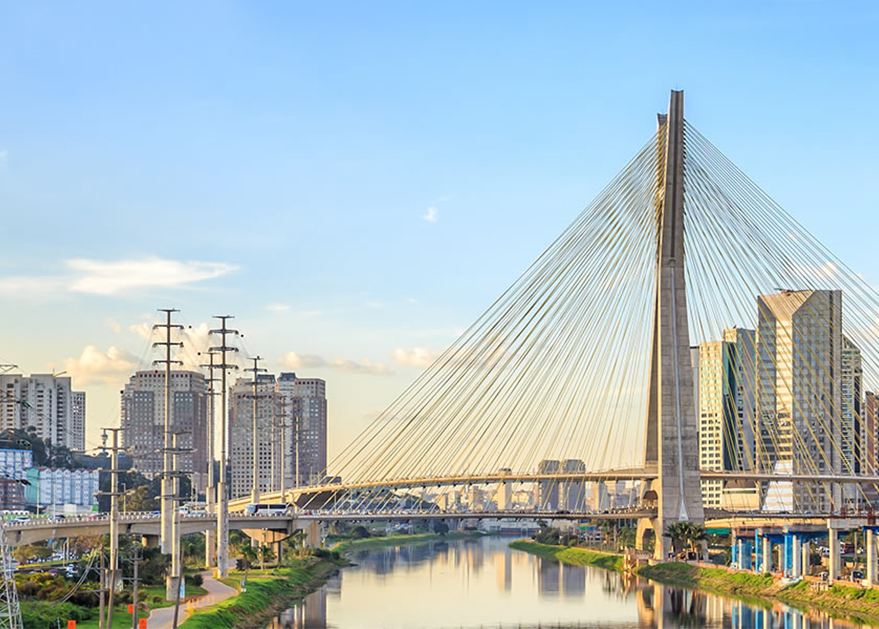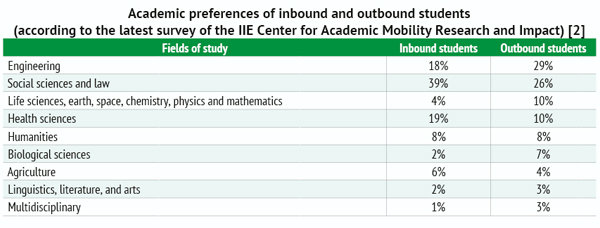Internationalization in Brazil: Academic Mobility

Over the past 25 years, Brazil has made a tremendous progress in development even though there was an economic recession in 2015-2016. Economic and social advancement has triggered an improvement of Brazilian HEIsʼ performance quality. Nowadays, the Brazilian higher education system complies with the world standards, which is reflected in international rankings. In December 2017, internationalization as a quality assurance criterion was included into the university evaluation list. In the modern era of internationalization of education, science and research utmost importance should be attached to international academic mobility and exchange.
International mobility: inbound and outbound flows
International academic mobility in Brazil has a long history dating back to the early 1950ʼs when two government bodies were established: the Coordination for the Improvement of Higher Education Personnel (CAPES) and the National Council for Scientific and Technological Development (CNPq). These organizations were responsible for funding bilateral education and research projects with different countries. In the 1970ʼs and 1980ʼs a significant number of Brazilian PhD candidates and researchers received their education abroad and then made an invaluable contribution to the development of the science and graduate education in their home country [1].
Over the last decade, some initiatives aimed at increasing international student and staff mobility have been introduced. Since 2011, state research foundations such as the São Paulo Research Foundation have offered a Grant for Research Studies Abroad to students enrolled in undergraduate, Masterʼs and PhD programs for spending up to one year in a foreign research laboratory or institution doing work related to their projects in Brazil. International student mobility is also actively promoted by the private sector. Students can apply for the Santander Bankʼs mobility program and the Fundação Estudarʼs studying-abroad program.
In July 2011, the Brazil Scientific Mobility Program (Science Without Borders) was created for the purpose of granting an opportunity for over 101,000 fully funded Brazilian students to study abroad at the best world universities and colleges in the science, technology, engineering, and math (STEM) fields by 2015. After two semesters and an internship, the students are supposed to return to Brazil to obtain their degrees.

For many years Brazilian students had chosen Portugal as one of the most popular study destinations, but the last three years have shown a change in studentsʼ preferences, with Canada, the USA, the UK, Australia and Ireland in Top-5 of countries accepting students from Brazil [3].
The so-called internationalization at home is one of the most important steps of the internationalization process. To attract more foreigners to Brazil, the following programs for incoming research students have been developed within the BSMP: Inbound Fellowships aiming to bring early-career researchers and senior scholars to Brazilian universities and research centers; the Young Talent awards fully funding one- to three-year research stays in Brazil; the Special Visiting Researchers fellowship offering a two- to three-year grant to senior researchers.
According to the latest research, 64% of the total population of over 20,500 international students enrolled in degree and non-degree programs chose to study in the Southeastern region known as the Brazilʼs economic and industrial hub. The most highly ranked and prestigious HEIs in the Southeast attracting many international students include the University of São Paulo, the State University of Campinas, the Federal University of São Paulo, and the Federal University of Rio de Janeiro.
Challenges and obstacles on the way to internationalization
In efforts to develop internationalization of higher education, Brazilian universities should take into account numerous economic, political, social and cultural factors. The recent political and economic turmoil in Brazil has led to slashing the science budget by more than 40%, while until 2014 the Brazilian governmentʼs investments in science and innovation had been very solid. Nevertheless, Brazilʼs government and HEIs remain committed to internationalization of education and science despite financial constraints. Fortunately, the turmoil had little effect on outbound mobility among Brazilian degree-seeking students, which remained relatively stable between 2011 and 2016, and the number of Brazilians studying abroad even increased by 14% between 2015 and 2016 [4]. In 2017, there was a 23% increase, with a record number 302,000. Overall outbound mobility has grown by nearly 40% over the last three years, showing a drastic improvement since 2015 [3].
FACT
Brazilian government and HEIs remain committed to internationalization of education and science despite financial constraints.
One of specific challenges in the development of bilateral academic mobility is language. There is a language barrier for both outgoing students who would prefer to study in the USA or Europe but have not met English language requirements and incoming students as very few Brazilian HEIs offer undergraduate programs or courses in English. Nevertheless, a number of successful double degree programs in engineering have been established between Brazilian research universities and European or American HEIs. In most cases, students can take courses in Portuguese as a second language. There is also a concern that the use of English as a medium of academic and scientific communication could discriminate Portuguese which is the official language in Brazil and a key uniting factor for this culturally diverse country. To advance in the world university rankings, universities from developing countries should do their research and publish in English as these rankings do not place much emphasis on what is done in other languages. More English articles should be published about Brazil to increase academic awareness of the country and an interest in research carried out in Portuguese for prospective incoming students and researchers [5].
Participants of exchange academic programs also have to face cultural and emotional challenges that can impact their academic performance and overseas experience. Therefore, intercultural competencies and behavioral, emotional and communication skills should be developed to make a stay in a foreign country successful.
FACT
77% of outbound and 83% of inbound students are pursuing an undergraduate education.
Another risk associated with outbound academic mobility is a possible brain drain in innovative and profitable fields as thousands of primarily STEM students go abroad to pursue their studies every year. This problem can be resolved by signing short-term post-scholarship repatriation contracts to have the students reside in Brazil for one or two years after their year abroad. Moreover, to achieve true success in internationalization, a balance between inbound and outbound mobility should be maintained. The internationalization process should be mutually beneficial to ensure “brain circulation” or “brain exchange” instead of brain drain [5].

Lioudmila BATOURINA, PhD,
International Partnership Consultant, ABMES
Brazilian Association of Private Universities
According to the first Brazilian Survey on Internationalization among private HEIs, 50% of them already have an international program in place and 50% are working on it. The first half of HEIs that have been already involved in the internationalization process offer short-term mobility for students (62%), short-term mobility for staff (30%), and joined or double degrees (23%). Participants of the survey consider that universities should do the following to make internationalization a reality:
- reinforce a foreign language as part of the formal curriculum—89%
- develop their ability to integrate international courses—62%
- provide student scholarships for outgoing mobility opportunities—58%
It should also be borne in mind that there are some difficulties with foreign diploma recognition in Brazil. When choosing an undergraduate or postgraduate course abroad, the student must take into account the equivalence in Brazil and which Brazilian university could do the revalidation of the diploma. Foreign undergraduate diplomas are revalidated by public universities only, while postgraduate degrees can be recognized by public and some private universities.
As Lioudmila Batourina, International Partnership Consultant at ABMES, mentioned in her presentation at the II Online Edu-Fair held as part of the Higher Education Discovery project [6], there are no extreme political, economic, geographic or intellectual limits against internationalization despite some specific obstacles and challenges that are to be overcome.
FAUBAI 2018: country case studies
On April 14-18, 2018, the Brazilian city of Fortaleza hosted the 30th Annual Conference FAUBAI 2018—Brazilian Association for International Education, with a general theme “Internationalization and Research: Challenges and Strategies.” It brought together over 770 participants from 29 countries representing all the continents. Discussions were held on issues related to comprehensive internationalization policies and the attractiveness of Brazilian research and Brazil as a destination for international students and researchers.
According to C. De Blasio and M. Björklund-Sänkiaho, academic mobility is a necessary starting point for internationalization of research. It is exemplified by fruitful long-term academic partnerships between Brazil and the USA that have involved a wide variety of students, faculty, administrators, and communities in both countries. This collaboration was catalyzed by the Science Without Borders program which also stimulated the creation of new infrastructures and processes on campus. Another initiative, the multi-year International Academic Partnership Program (IAPP), provided a framework for US and Brazilian institutions to deepen their academic and scientific relations. The current best practices in sustaining education partnerships and opportunities for expanding them to include research and faculty exchange opportunities were discussed at the conference [7].
The cross-cultural issues related to international academic mobility were also covered. To successfully implement mobility programs and bring positive results to both the student and the institution, international experience must be thought out, planned and monitored beyond the academic perspective taking into account the intercultural bias and a necessity to develop the participantʼs intercultural awareness and competence [8]. At the conference strategies and activities were introduced in order to strengthen both inbound and outbound processes, focusing on studentʼs intercultural education and skills. It included best practices for selection methods, preparation, a re-entry process, the sharing of student experiences, all aimed at the successful academic, professional and intercultural experience of mobility.
Much emphasis was placed on linguistic challenges that could hinder the process of internationalization in Brazil, in particular, the constant changes in the law on additional languages at schools and a controversy between the necessity of learning English and some protests against the hegemony of the English language in the educational system [9].
As part of discussions of language education as an essential and integral component of internationalization, the Canada-Brazil model of institutional partnership and student mobility was presented by the partners, Languages Canada and Idiomas sem Fronteiras. It integrates the following components: (i) development of a certificate which will qualify Canadian students to serve as a Foreign Language Teachersʼ Assistant in a Brazilian language education classroom; (ii) access for Canadian students to learn Portuguese through IsFʼs Portuguese for Foreigners stream; (iii) comprehensive mobility support for students, including travel, insurance and housing; (iv) creation of a recognition scheme within participating Canadian universities to acknowledge the experience in Brazil within the studentsʼ graduation qualifications; and (v) support and/or enhancement of existing Canada-Brazil mobility schemes [10]. Universidade Estadual do Norte do Paraná (Brazil) and Trent University (Canada), that signed a cooperation agreement in 2017, presented their collaborative project for internationalization using a blended language learning model and curriculum partnerships. These two HEIs make a mutual contribution to curricula and syllabi and exchange their methodologies. They have created a true global classroom where students of both universities can share assignments and do joint projects [11].
The recent advancements in the development of internationalization and increased academic mobility rates show that Brazil is on the right track but internationalization still has a limited experience and most universities and students do not have sufficient information about this phenomenon. Therefore, the international interaction between Brazil and other countries still needs to be significantly improved by strengthening HEIsʼ relationships with foreign universities.
REFERENCES
1. Vergani, C.E. International mobility of students in Brazil. [Online] Available URL: https://unchronicle.un.org/article/international-mobility-students-brazil [Accessed May 24, 2018]
2. Robles, C. and Bhandari, R. Higher Education and Student Mobility. A Capacity Building Pilot Study in Brazil. [Online] Available URL: https://www.capes.gov.br/images/stories/download/diversos/23112017-High-Education-and-Student-Mobility-Brazil-Pilot-2.pdf [Accessed May 24, 2018]
3. Brazil marks a second year of strong growth [Online] Available URL: http://monitor.icef.com/2018/04/brazil-second-year-strong-growth/ [Accessed May 24, 2018]
4. Going North: The Student Mobility Outlook from Brazil, Colombia, Mexico, and Venezuela. [Online] Available URL: https://wenr.wes.org/2017/09/going-north-the-student-mobility-outlook-from-latin-america [Accessed May 24, 2018]
5. Campbell, Kathleen. Bilateral student mobility in Brazil: language as a double-edged sword in internationalization. [Online] Available URL: https://www.cairn.info/revue-journal-of-international-mobility-2015-1-page-129.htm [Accessed May 24, 2018]
6. HEDClub international education advertising website [Online] Available URL: https://hedclub.com/
7. De Blasio, C. and Björklund-Sänkiaho, M. Mobility as a necessary starting point for internationalization of research. An overview with experiences from the FinCEAL and Erasmus Plus programs. [Online] Available URL: http://www.faubai.org.br/conf/2018/program/ [Accessed May 24, 2018]
8. Tomaszewski Homen de Góes, K. The intercultural dimension to mobility in the internationalization of higher education. [Online] Available URL: http://www.faubai.org.br/conf/2018/submissions/modules/request.php?module=oc_program&action=view.php&id=44&file=1/44.pdf [Accessed May 24, 2018]
9. Sarmento, S. and Knijnik Baumvol, L. Languages and Internationalization of Higher Education: An analysis of FAUBAI Conferences. [Online] Available URL: http://www.faubai.org.br/conf/2018/program/ [Accessed May 24, 2018]
10. Lindsay, R., Peralta, G. and Abreu e Lima, D. Language education as a foundation and catalyst for internationalization partnerships and student mobility: a Canada-Brazil model. [Online] Available URL: http://www.faubai.org.br/conf/2018/program/ [Accessed May 24, 2018]
11. Segati Rios Registro, E., Fish, G. and D'Amico, C. Collaborations for Internationalization: Blended Language Learning and Curriculum Partnerships, Brazil and Canada. [Online] Available URL: http://www.faubai.org.br/conf/2018/program/ [Accessed May 24, 2018]
12. Niskier, C. and Batourina, L. ABMES INTERNATIONAL Survey on Internationalization. Key findings. [Online] Available URL: http://www.faubai.org.br/conf/2017/submissions/modules/request.php?module=oc_program&action=view.php&id=21&file=1/21.pdf [Accessed May 24, 2018]